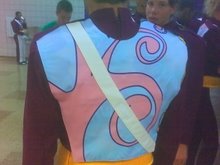Competitive Marching Show Design, examined through three standards
For Marching Band and Drum Corps, there is no question more fundamental to the activity than that of show design. The field show is at the heart of all marching units, competitive or not, and is the most public display of a units’ skills. Many units are judged, both formally and informally, on the strength of the show they perform on the football field. Far from the early days where parades and reviews reigned, the field show has been king of the marching activity for nearly 50 years. this post also appears on the Standing 'o' articles page as a PDF here
Now, the obvious question is asked, what constitutes a good show design? This question is heavily dependant upon a few factors, mainly the purpose of the performance. A “halftime” band serves a completely different function than a competitive one and the show design should reflect this.
For the purposes of this article, I will examine show design as it relates to competitive marching bands only. Shows in this realm have to meet some very specific standards in order to be successful. The ideas I advance in this article focus on the three major factors that determine the success of a competitive high school marching band – complexity, accessibility, and the intangibles. While bands may be successful without utilizing the full depth of each of the three standards, I will argue that the most successful programs incorporate them to a high degree. I will first define the three factors, give examples of each of their uses, and finally synthesize all three factors to examine a “total” show.
Complexity
Complexity refers to the written difficulty of the musical and visual books. Bands that incorporate difficult drill moves and musical ideas have a greater potential to score higher than do bands that perform easier repertoire. The concept of complexity is broken down in the judging paradigm into two parts – 1) what the potential of the show is, and 2) how well the students are performing it. The goal, of course, is to create a demand that is achievable by the students, yet difficult enough to be recognized by the judges as a performance accomplishment. Two examples;
• A band flying around the field at large step sizes performing Bach’s “Toccata and Fugue, in d minor” will be recognized for a large demand, however it is extremely improbable the performance level will be very high. The judges will mark them down for not performing at the level demanded by the show.
• A band performing a grade one arrangement of “Lighty Row” while marching at a 16 to 5 down the field will be recognized for achieving a high performance level. The judges will most likely mark them down for the show not demanding enough of the performers.
The ideal level for material to be written is in what educators call the “zone of proximal development.” This is the level that students are not able to easily perform at first, however, through practice and rehearsal, are able to achieve by the conclusion of the season.
A popular approach to writing the correct difficulty for the show is to initially “over-write” the show for the performers. Because no one can accurately gauge at the beginning of a season the “zone” things need to be written in, arrangers will most often try and keep the musical parts difficult in the beginning of the season. As the season progresses, the improvement in the performers’ abilities are assessed and, if need be, parts can be cut or rewritten to accommodate specific difficulties. This is often referred to as “watering”, or “hosing” the parts down so the performers can be more successful in performing them. This process is, for the most part, a musical process, as drill and visual elements are more difficult to change mid-season.
There are a few things both staff, designers, and students can do to increase the complexity rating of a show. The design team has the obvious task of writing material that is sufficiently difficult and challenging to perform. The technical staff has an important role to play in that they need to have the skills necessary to recognize the difficulty in the material and to teach students to overcome that difficulty in an effective manner. The student responsibility lies in becoming better musicians. This means practicing at home, extra sectionals, and getting help from staff members as needed. The student component is critical for any band program that is looking to build long-term success.
Accessibility
The next factor to a successful show is that of accessibility. This is the measure of how familiar and clear the design ideas are that you present to the audience. Crowd and parent response to the show concept is a major motivating factor for a band program. It can increase enrollment, retainment, school support, administrative support, and even financial support.
The easiest way to make a show accessible is to play music that people are familiar with. Popular music charts are more the domain of “halftime” bands, but the competitive band could do well by sneaking them in at some point in the show. Many classical and jazz pieces have also made the jump from “art” music to “popular.” A common problem with playing popular music is the performing band has to meet the preconceived notions the audience has for that particular piece. Stray too far from the source material and you may leave some people behind simply because you “messed” with their tune.
Another way to make shows accessible is through a clear and simple concept. People won’t mind un-familiar music if the concept of the show is sold to them clearly. Shows that tell a story, or engage in some type of narrative format are generally seen as more accessible than more esoteric designs. A show on “Romeo and Juliet” has a better chance of being understood than does a show entitled “Genesis: rebirth from darkness.”
The students will also appreciate accessible show designs. Not only might they understand the concept, but they may also recognize the music they are playing. This automatically involves them in the show in more ways than being simply a performer. The more connections a student can make with the show, the better they can perform the program. An increased audience response also gives a psychological boost to the performer and can serve as additional extrinsic motivation for them
Unlike the other two standards, accessibility rests directly on the shoulders of the show designers. Once the music and visual packages are developed, neither the staff, nor students can do much of anything to affect the show appeal beyond simple execution. I would argue that accessibility be an important design consideration from the initial stages of the design process.
The Intangibles
What I mean by the intangibles are all of the factors that affect the collective band in positive or negative ways. Some factors include the staff leadership, the student leadership, the parental involvement, the band history, and personality of the students. A good show designer needs to take these factors into account just as they would complexity or accessibility.
In order to get a pulse on these factors, it takes keen observational skills, a focused band program, and above all else, time and perspective. A director who has been involved with one program over a long period of time will better be able to suit show concepts that fit with the intangibles of the band of a particular year. Also, the established expectations at long-running programs create stability which is an important contributing factor to success through the show design. Students can rehearse more effectively if they understand the expectations for a smooth rehearsal are already established and followed.
There are certain things the design team, the technical staff, and the students are responsible for in defining “the intangibles” for a band program. The design staff needs to be tuned into the personality of the band and design shows based upon what fits best. A band of younger rookies may not have the maturity to tackle a show, for example, on the fall of communism.
The technical staff has the responsibility of defining the operational and logistical standards of the band. This includes creating effective student and staff hierarchies, defining proper rehearsal technique, implementing a discipline structure, and executing teaching strategies that promote positive achievement. Of the three standards discussed in this paper, this is the standard most affected by technical staff involvement. There are reasons why successful band programs always have an acclaimed, constant technical staff. The manner in which the above operational standards are executed is the most important determining factor in creating a positive band atmosphere.
The students also share responsibility in creating “the intangibles.” Student leaders should be experienced in the activity and hold the respect of other members and staff. The manner in which the upperclassmen and the student leaders carry themselves and the attitudes they hold about the band program are very contagious to the band as a whole. The students can also be an important source of energy, or “hype” for the band program itself.
Combining the three elements…
Shows can and have been successful in utilizing these factors at different levels. I contend that great show designs strive for maximum effectiveness in all three of the areas discussed above. Never settle. With a few changes, every program put on a marching field can “max-out” each of the standards.
___________________________________drum corps ;
DCI ;
marching band


No comments:
Post a Comment